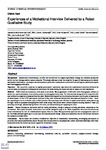Experiences of a motivational interview delivered by a robot: qualitative study
| dc.contributor.author | Galvão Gomes da Silva, J | |
| dc.contributor.author | Belpaeme, Tony | |
| dc.contributor.author | Kavanagh, DJ | |
| dc.contributor.author | Taylor, L | |
| dc.contributor.author | Beeson, K | |
| dc.contributor.author | Andrade, Jackie | |
| dc.date.accessioned | 2018-01-26T14:52:00Z | |
| dc.date.available | 2018-01-26T14:52:00Z | |
| dc.date.issued | 2018-05-03 | |
| dc.identifier.issn | 1438-8871 | |
| dc.identifier.issn | 1438-8871 | |
| dc.identifier.other | ARTN e116 | |
| dc.identifier.uri | http://hdl.handle.net/10026.1/10669 | |
| dc.description.abstract |
BACKGROUND: Motivational interviewing is an effective intervention for supporting behavior change but traditionally depends on face-to-face dialogue with a human counselor. This study addressed a key challenge for the goal of developing social robotic motivational interviewers: creating an interview protocol, within the constraints of current artificial intelligence, which participants will find engaging and helpful. OBJECTIVE: The aim of this study was to explore participants' qualitative experiences of a motivational interview delivered by a social robot, including their evaluation of usability of the robot during the interaction and its impact on their motivation. METHODS: NAO robots are humanoid, child-sized social robots. We programmed a NAO robot with Choregraphe software to deliver a scripted motivational interview focused on increasing physical activity. The interview was designed to be comprehensible even without an empathetic response from the robot. Robot breathing and face-tracking functions were used to give an impression of attentiveness. A total of 20 participants took part in the robot-delivered motivational interview and evaluated it after 1 week by responding to a series of written open-ended questions. Each participant was left alone to speak aloud with the robot, advancing through a series of questions by tapping the robot's head sensor. Evaluations were content-analyzed utilizing Boyatzis' steps: (1) sampling and design, (2) developing themes and codes, and (3) validating and applying the codes. RESULTS: Themes focused on interaction with the robot, motivation, change in physical activity, and overall evaluation of the intervention. Participants found the instructions clear and the navigation easy to use. Most enjoyed the interaction but also found it was restricted by the lack of individualized response from the robot. Many positively appraised the nonjudgmental aspect of the interview and how it gave space to articulate their motivation for change. Some participants felt that the intervention increased their physical activity levels. CONCLUSIONS: Social robots can achieve a fundamental objective of motivational interviewing, encouraging participants to articulate their goals and dilemmas aloud. Because they are perceived as nonjudgmental, robots may have advantages over more humanoid avatars for delivering virtual support for behavioral change. | |
| dc.format.extent | e116-e116 | |
| dc.format.medium | Electronic | |
| dc.language | en | |
| dc.language.iso | en | |
| dc.publisher | Journal of Medical Internet Research | |
| dc.subject | robotics | |
| dc.subject | counseling | |
| dc.subject | motivational interviewing | |
| dc.subject | motivation | |
| dc.subject | exercise | |
| dc.subject | qualitative research | |
| dc.subject | computer-assisted therapy | |
| dc.subject | person-centered therapy | |
| dc.title | Experiences of a motivational interview delivered by a robot: qualitative study | |
| dc.type | journal-article | |
| dc.type | Article | |
| plymouth.author-url | https://www.webofscience.com/api/gateway?GWVersion=2&SrcApp=PARTNER_APP&SrcAuth=LinksAMR&KeyUT=WOS:000431334800001&DestLinkType=FullRecord&DestApp=ALL_WOS&UsrCustomerID=11bb513d99f797142bcfeffcc58ea008 | |
| plymouth.issue | 5 | |
| plymouth.volume | 20 | |
| plymouth.publisher-url | http://www.jmir.org/2018/5/e116/ | |
| plymouth.publication-status | Published online | |
| plymouth.journal | Journal of Medical Internet Research | |
| dc.identifier.doi | 10.2196/jmir.7737 | |
| plymouth.organisational-group | /Plymouth | |
| plymouth.organisational-group | /Plymouth/Admin Group - REF | |
| plymouth.organisational-group | /Plymouth/Admin Group - REF/REF Admin Group - FoH | |
| plymouth.organisational-group | /Plymouth/Faculty of Health | |
| plymouth.organisational-group | /Plymouth/Faculty of Health/School of Psychology | |
| plymouth.organisational-group | /Plymouth/Faculty of Science and Engineering | |
| plymouth.organisational-group | /Plymouth/REF 2021 Researchers by UoA | |
| plymouth.organisational-group | /Plymouth/REF 2021 Researchers by UoA/UoA04 Psychology, Psychiatry and Neuroscience | |
| plymouth.organisational-group | /Plymouth/REF 2021 Researchers by UoA/UoA04 Psychology, Psychiatry and Neuroscience/UoA04 REF peer reviewers | |
| plymouth.organisational-group | /Plymouth/Research Groups | |
| plymouth.organisational-group | /Plymouth/Research Groups/Centre for Brain, Cognition and Behaviour (CBCB) | |
| plymouth.organisational-group | /Plymouth/Research Groups/Centre for Brain, Cognition and Behaviour (CBCB)/Cognition | |
| plymouth.organisational-group | /Plymouth/Research Groups/Institute of Health and Community | |
| plymouth.organisational-group | /Plymouth/Research Groups/Marine Institute | |
| plymouth.organisational-group | /Plymouth/Research Groups/Plymouth Institute of Health and Care Research (PIHR) | |
| plymouth.organisational-group | /Plymouth/Users by role | |
| plymouth.organisational-group | /Plymouth/Users by role/Academics | |
| dc.publisher.place | Canada | |
| dcterms.dateAccepted | 2017-12-23 | |
| dc.identifier.eissn | 1438-8871 | |
| dc.rights.embargoperiod | Not known | |
| rioxxterms.versionofrecord | 10.2196/jmir.7737 | |
| rioxxterms.licenseref.uri | http://www.rioxx.net/licenses/all-rights-reserved | |
| rioxxterms.licenseref.startdate | 2018-05-03 | |
| rioxxterms.type | Journal Article/Review |


